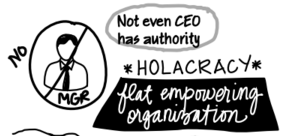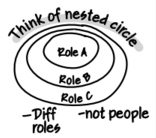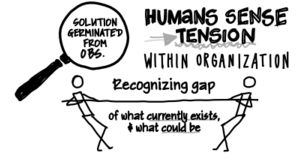It is often heard that Holacracy feels robotic, rigid and inhuman for the people working with it. Also the implementation is often not as easy going as wished and employees struggle with the new system in the beginning. Why the struggle is often just habit adjustment and why you should create space for human to human interaction is answered by Holacracy inventor Brian Robertson in this interview. We asked some questions about typical challenges that occur during implementation.
Brian, what are the most important organisational factors to successfully implement Holacracy?
 The operational leader of the company, the person with the authority over the company or that part of the company, has to be deeply committed. And not just committed to letting other people change but committed to change their own leadership style, committed to learning a new way to influence and get work done. And they have to have the long term vision and looking at it as a 5 year journey not just a quick fix. Their commitment and buy in is the single most critical factor.
The operational leader of the company, the person with the authority over the company or that part of the company, has to be deeply committed. And not just committed to letting other people change but committed to change their own leadership style, committed to learning a new way to influence and get work done. And they have to have the long term vision and looking at it as a 5 year journey not just a quick fix. Their commitment and buy in is the single most critical factor.
You know it is really surprising what other factors aren”t required for a successful implementation, like the cultural readiness, the other leaders in the company, the health of the team, all of these will help with Holacracy adoption. But none of them seem to be absolutely required before Holacracy, it is almost like you can work on it during it.
How do you realize that the person is really committed? Everybody wants to get agile and responsive to the market these days. But not everyone has a real idea of what it means to adopt Holacracy.
Brian: Absolutely. I look for… if they are talking about how they intellectually want to benefit from Holacracy. Statements like: ”I have done the analysis and I understand that there are benefits of being agile and its good for business.” And it”s all intellectual versus the kind of people who are much more likely to be really committed. There it is a value thing, it”s an emotional thing, it”s an intuitive thing. When you see it is aligned with the way the leader sees the world, it”s the paradigm they are already kind of operating in. They just don”t have a concrete way to apply it… That goes so much further than the intellectual commitment.
I can imagine that it has also to do with how they set the culture within the company, kind of: this is how it is gonna be, it”s not a ”we try” but a ”this is it”.
There is a great example of Tony Hsieh, the CEO of Zappos, when they adopted Holacracy. He talked about when the early settlers went into North America from Europe. Kolumbus had his people burned the ship with that they came over as soon as they landed. Because he wanted to make the point: “We are not going back, we are not trying to see if this works, we are settling this land and there is no going back”. And that was Tony”s metaphor for adopting Holacracy, the one of burning the ships. He wanted everyone to know that they are not going back to management as we are used to: This is a one way trip, we are changing and that it is, burn the ships!
That is, I think, a great mindset. It can work if they are communicating more like we are going to try it, but their own attitude has to be: there is no way of going back. Whatever they say for the languaging, the messaging, there are different ways of stepping into that. And I see some leaders doing fine with ”Ok, we are just going to try it”, but they knew it was not just trying, they knew they were in.
On the employee level, what would you say are the aspects employees struggle on a personal level?
Oh there are so many different things. One of them is, just very practical: how do I get work done in this new system? So it”s the concrete Holacracy skills. But it is more than just skills, it is habit. So the habits on how to get work done. And so many of the habits that people are used to and managed priorly are not going to serve well in Holacracy. So there is a need to kind of unearth the old habits, unlearn them and replace them with new habits. And that”s even harder because people can intellectually understand: here is how Holacracy works and here is how I should get things done in Holacracy. But the problem is a lot of the ways we behave are not coming from intellectually thinking about our behaviour, they are coming from automatic habits. So for example: I have seen people intellectually get that there are no longer going to be meetings to search for consensus, instead they have to get clear what role makes the decision and then lea d if that”s their role or refer to another role. I can talk to somebody and hear them articulate that, intellectually they get it, and then in the next breath they are going to say: “So team, what do you think we should do about this group decision?” instead of getting clear on the roles. And it is just habitual, they are not even aware that they are doing it. And it is one of the biggest, we can capture it partly by Holacracy skills, so they do know intellectually on what they should do but the challenge is much deeper than that, it is the habit change. Even worse, with the old habits Holacracy pushes back on them, so it gets harder to get work done. So there is that frustration that comes until they figure out how they can use the system, use the rules.
d if that”s their role or refer to another role. I can talk to somebody and hear them articulate that, intellectually they get it, and then in the next breath they are going to say: “So team, what do you think we should do about this group decision?” instead of getting clear on the roles. And it is just habitual, they are not even aware that they are doing it. And it is one of the biggest, we can capture it partly by Holacracy skills, so they do know intellectually on what they should do but the challenge is much deeper than that, it is the habit change. Even worse, with the old habits Holacracy pushes back on them, so it gets harder to get work done. So there is that frustration that comes until they figure out how they can use the system, use the rules.
So they need the time to get used to the system, to understand it and then say: ok, I need some time to adjust. Not only the others, but I do as well?
Yes. Often it is said that people are not open to change or there is resistance to change and I think that it”s missing the point. More often than not, what looks like resistance to change is just somebody not knowing what to do instead. But they need to understand the new way to get work done and then they need to make it enough of a new habit so that they don”t have to think about it all the time.
So if they get enough support in, let”s say for example in new working habits with training or peer support, you would say it is much easier for them to just get used to it?
Yeah, a good coach working with them to kind of help them understand how to do this is good. In the old days as a boss, you would have just told a person not to do something. What do you do now instead with Holacracy? You can”t just tell someone what they should do. But you can get you knee in, you can propose constraints, you can have accountabilities.
The other big one that comes up is self-management, but I mean in terms of literally managing your individual work, like getting a good system. Like getting a good GTD, getting things done, practice. Or any kind of individual organisation. You have all these rules and all these projects and all these actions. You have to take on more responsibility in organising them consciously, you can”t just chase the latest thing your boss is screaming for.
And then the last big challenge is on an identity level, it”s especially from old managers. They often have their identity tied into: “I am a manager, I have achieved this status in my career”. And now that”s kind of getting undermined. Their sense of self-worth often comes from: “I am valuable because I have achieved this level”. The underlying thing is: I need a new self story, I need a new story I can tell myself of why I am worthy, valuable, good and important to this organization.
What skills and competences do employees need to find themselves well in the system?
 There are several. One of them is sensing tension and capturing them. Which sound simple but it is actually hard. People walk around and they don”t notice many of the tensions. Because they have been trained that there is nothing they can do about most of them, so why bothering noticing them. Or if they do notice them, they don”t capture them, they don”t write them down and they don”t bring them up, they just live with it.
There are several. One of them is sensing tension and capturing them. Which sound simple but it is actually hard. People walk around and they don”t notice many of the tensions. Because they have been trained that there is nothing they can do about most of them, so why bothering noticing them. Or if they do notice them, they don”t capture them, they don”t write them down and they don”t bring them up, they just live with it.
Another key skill is to shifting into thinking in terms of roles. And that shows up with one of the habits we try to build for that is when you communicate with someone, tell them what role you are talking to them in and what role you are coming from.
And another one is, probably the third key one, is when you are influencing… kind of getting the skill of making a request and knowing what your request is. So this is one of the things that happens with Holacracy, you are going from showing up and sharing a frustration with somebody and hoping they are following you to asking for specific things. The five most common ones are: you can request someone to do something, to take an action. You can request somebody to work towards an outcome, which is a project. And those are totally different requests. You can request too that people just listen or to get information or ideas from them. Or the fifth and the key one, I want to set a new ongoing expectation. And in most companies today people don”t differentiate, they just feel like “I want something”. And in Holacracy, the skill is to know how to make a request and to know what the different requests are. So you see this day to day outside of meetings. One of the big misconceptions of Holacracy is that it is all about the meetings and what you do in meetings. It is not, it”s all about what happens between the meetings. The meetings are just a little stepping zone to get you there. But in between meetings, in a mature Holacracy covered company, what you see is, clear requests.
One of the main pain points employees experience is a missing team spirit. What”s your experience on that topic?
This one is really common. It happens usually anywhere from 6 weeks to a few months into the adoption. People in a typical company are using their meetings to do the cultural human to human connection thing. And what Holacracy is doing is actually pulling apart their meeting and saying: “No, this is a meeting where we really focus on disciplined organisational work”. So there is less space to do all that personal human connecting in the typical meeting, especially in the governance process. And what”s the feeling, that people get from that is: “Oh my god, Holacracy is inhuman and it is tearing apart the way we are connected, it feels awkward and robotic and mechanical.” The interesting thing is that governance meetings use about 1 percent of the time in an organisation. The other 99 percent can be used to be human and connected and build your tribe and your culture and all that. And 1 percent could be saved to the disciplined focused work, so people can get tensions addressed and get them out of the way.
So sometimes people need new ways to connect human to human because there meetings are no longer the space for that. So they might need another space for that. So there is a transmission needed but sense is, even if you have all those spaces people still feel the shock and the push back and the pain in the beginning.
We thank Brain for these interesting insights.
Questions and thoughts on that topic are always welcome.
Pictures by Adam Torren

